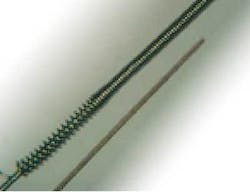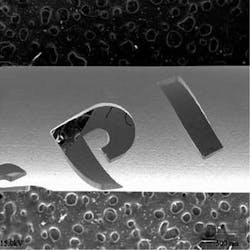Medium-power fiber lasers
While much fiber laser hype focuses on high-power generation, single-mode fiber lasers at powers up to 200 W form the largest market segment by far
Tony Hoult and Gregory Flinn
Fiber lasers are popular for laser marking and materials processing applications such as micro-welding and micro-cutting. Further applications are to be found in the printing industry, in the processing of semiconductor and electronic components, and also for materials micro-processing such as micro-bending or rapid prototyping (see Figure 1).
Many of these applications are served by fiber laser powers up to 200 W, and these systems form the majority of all fiber laser sales.1 Fiber lasers at this power level are able to compete effectively in many applications with other lasers and, generally, sales are as replacements for these conventional technologies. Typically the customer is already familiar with laser technology, but is looking for additional performance with reduced maintenance issues in the production line process.
Fiber lasers are available either as continuous-wave (CW) or as pulsed systems. More frequently a CW beam is amplitude modulated creating pulses from microseconds through to full CW to better suit the requirements of the application. For cutting and welding applications, for example, a short excess in power is required to start the process at the surface, whereas less power is required to continue the process below. A train of such pulses is then used to produce a quasi-continuous cut or weld in the material being processed. For marking applications, however, it is more usual that a threshold process is involved, for example to produce a color change in the material, and thus more critical here is a pulse peak power. In general, Q-switched systems are used to generate the very high peak powers required.
Materials processing with 200W fiber lasers
Critical for many industrial materials processing applications is stability and flexibility in the rate of delivery of the laser energy. Most applications require a dynamic modulation of the laser power to achieve optimal processing performance. Additional parameters important for industry are a small equipment footprint, elimination of calibration and alignment routines, and adaptability to existing production processes.
SPI has recently introduced a new high-power, CW modulated fiber laser system to the market, delivering up to 200 W and thus capable of addressing a wider range of applications. Output power stability makes this laser ideal for cutting applications, whereas the dynamic range of pulse lengths and repetition rates make the laser an ideal tool for welding applications.
Today, fiber lasers are used on a broad spectrum of metals and plastics in industrial processing applications, including micromachining of medical grade stainless steels, mild and carbon steels, tungsten, molybdenum, and various alloys (titanium, light metal alloys, precious metal alloys) as well as clear and dark plastics.
Fiber lasers are used in the manufacture of a wide range of components for mobile telephones, automotive engine bay and instrument panel parts, plasma screen back lighting elements and housings, medical instrumentation, medical stents and pacemakers, flexible circuitry, printing drums, rapid part manufacture using sintered metals, and food packaging.
Microwelding of metals and plastics
High-quality laser welding requires an exceptionally stable output power. In metals, a CW beam is amplitude modulated to provide a train of spot welds that mimics very closely the characteristics of a continuous weld (see Figure 2). Material parameters such as thermal diffusivity, surface reflectivity, and melting point critically determine minimum and maximum power levels and affect the final weld quality. Optimizing the weld process involves selecting the best combination of weld speed and modulation parameters for any one material and thickness.
Medical instrumentation, medical implants, and components for the electronics industry often use 304-type stainless steel, with wall thicknesses of 0.1 to 1mm. The specifications for the quality of such welds are set very high, although the weld process for such thin materials can be difficult-too much power can result in excessive penetration and thus weak points and perforation, while too little power can result in weak weld strength. Fiber lasers with up to 200W average power produce welds in these metals with the desired quality, with smooth weld seams free of both debris and voids.
For plastics, the power requirements are significantly lower, though fast scan speeds to achieve high coverage rates make the 50-200W laser range ideal. Welding often employs a transmissive technique where one component of the joint is transmissive and the other absorptive-the laser generates heat at the joint and controlled whetting or melting forms the weld. The use of special plastics to enhance the process, for example those that appear dark but in reality transmit enough of the laser light, is increasing.
While the benefits of a true TEM00 laser are less tangible in the plastic welding applications, the use of a maintenance-free, no-calibration or lamp-changes laser is vital on the automotive factory floor, and the cost benefits of an industrialized simple-to-use laser when deployed in volume are very real.
A new technique involves the welding of clear or light-colored plastics. In this case, a special coating between the two surfaces to be joined is irradiated with the laser beam. Careful control of clamping forces and the laser parameters ensures proper absorption in the coating, causing controlled melting and ultimately a strong, transparent weld.
Microcutting
Just as for laser welding, the quality of laser cutting is strongly dependent on several parameters: the depth of focus, the power stability, the cutting speed, and the material parameters are all deciding factors. A long depth of focus provides for symmetrical and flat walls of the cut, while a stable laser power guarantees these physical aspects over the entire length of the cut. A stable cutting performance is again especially important for thin-walled materials, which is otherwise observed as debris on the underside of the cut.
For a particular thickness of any material there is a certain cutting speed and average power at which the minimum heat input is achieved. This heat input corresponds directly to the best cutting quality, which in turn corresponds to minimum dross (or ease of dross removal), minimum discoloration, and minimum cut surface roughness. Additionally, for a particular cutting speed, material thickness, and material type, there is a certain minimum average power required to cut, and this power needs to be found at the minimum duty cycle (see Figure 3).
In the medical industry, these lasers are used to cut stents out of thin-walled tubes (see Figure 4). With a diameter of 0.8-1.2mm and wall thicknesses below 0.2mm, these stents are generally prepared out of 304-type stainless steel, but also out of CbCr, Nitinol, and other exotic alloys. This industry in particular has benefited from the adoption of fiber laser technology both in terms of reduced production costs and an improved end product. Such stents are surgically placed within constricted veins and arteries to help improve blood flow, the smallest being used for blood vessels within the brain and the largest within the thigh.
null
RP and manufacturing
A range of processes is now available that comes under the general heading of rapid prototyping or rapid manufacturing. These processes have affected product development by reducing development times and are starting to change manufacturing. Many of these processes use industrial lasers as an energy source.
Laser sintering of appropriate metal alloys is one application that can make good use of fiber laser technology, being used to produce tooling and even fully functional 3D parts. The functionality of laser sintered components has improved to the point at which they are sometimes indistinguishable, at least from a performance standpoint, from conventionally produced components (see Figure 5).
(photo courtesy) MCP Tooling Technologies
The beam parameters of the fiber laser and its flexibility are the source of several advantages for this sort of application: beam intensity and small spot size enable the use of very fine powders, high power stability enables complex and consistent lattice structuring, and high power and high power density capability allow large structures to be processed. Also high beam quality means large stand-off distances and permits large structures, and beam intensity and stability allow high density of fill and a smooth finish.
Additionally, the high reliability, zero thermal lensing, and high efficiency of the fiber laser improves the overall yield of a rapid prototyping system, at the same time guaranteeing better quality of the prototype component.
The market for fiber lasers is expected to grow further, for example with applications in the printing industry (gravure), in additional areas of the medical industry, and in rapid 3D prototyping. SPI is also developing new fiber lasers3 with kilowatt output powers, comparable to those already being used for welding in the automobile industry.
References
1. Laser Marketplace 2005, Laser Focus World, January 2005, p.83.
2. M.N. Zervas, et al, “Single and few-moded high power fiber lasers for industrial applications,” Conference on Advanced Laser Applications Technology November 2004.
3. W. O’Neill, M. Sparkes, M. Varnham, et al, “High Power High Brightness Industrial Fiber Laser Technology,” Proceedings ICALEO 2004.
Dr. Tony Hoult ([email protected]) is applications manager for SPI Lasers, Southhampton, UK, and Dr. Gregory Flinn ([email protected]) is with Putting Photonics into Context, Munich, Germany.





